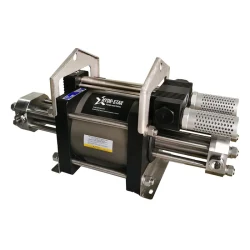Key points to understand about hydro-pneumatic booster systems
2024-01-19
Hydro-pneumatic booster systems, also known as hydro-pneumatic accumulators or hydraulic accumulators, are devices used in hydraulic systems to store energy and assist in the performance of specific functions. These systems combine the principles of both hydraulic and pneumatic technologies. Here are key points to understand about hydro-pneumatic booster systems:
1. Hydraulic System:
- Fluid Power: Hydraulic systems use pressurized fluid (usually oil) to transmit power. They are commonly employed in various industrial applications, including machinery, automotive systems, and manufacturing processes.
2. Pneumatic System:
- Compressed Air: Pneumatic systems use compressed air to transmit power. They are known for their quick response and are often used in applications where rapid and precise movements are required.
3. Hydro-Pneumatic Booster System:
- Combination of Technologies: Hydro-pneumatic booster systems combine elements of both hydraulic and pneumatic systems to provide specific benefits.
- Energy Storage: These systems typically incorporate an accumulator that stores hydraulic energy in the form of compressed gas (usually nitrogen) and hydraulic fluid.
4. Functionality:
- Energy Recovery: Hydro-pneumatic booster systems can recover energy during low-demand periods and release it during high-demand periods. This helps in optimizing energy usage and improving overall system efficiency.
- Shock Absorption: The accumulator in the system can act as a shock absorber, reducing the impact of sudden pressure spikes or shocks within the hydraulic system.
- Emergency Power Source: In the event of a power failure or pump shutdown, the stored energy in the accumulator can be used as an emergency power source to perform critical functions.
5. Applications:
- Industrial Machinery: Hydro-pneumatic booster systems are commonly used in industrial machinery, especially in applications where precise control of force, speed, or energy efficiency is important.
- Automotive: They can be found in automotive systems, such as in braking systems, where they contribute to improved efficiency and responsiveness.
- Aerospace: Some aerospace applications utilize hydro-pneumatic systems for tasks like landing gear operation.
6. Components:
- Accumulator: The accumulator is a key component that stores hydraulic energy in the form of compressed gas. It consists of a gas side and a fluid side separated by a piston or bladder.
- Control Valves: Control valves are used to regulate the flow of hydraulic fluid and control the operation of the system.
- Pump: A pump is responsible for pressurizing the hydraulic fluid and charging the accumulator.
7. Advantages:
- Energy Efficiency: Hydro-pneumatic systems contribute to energy efficiency by capturing and reusing excess energy.
- Precision Control: These systems enable precise control over force and speed in hydraulic applications.
- Reduced Wear and Tear: The shock absorption capability of hydro-pneumatic systems helps in reducing wear and tear on components.
Hydro-pneumatic booster systems are versatile and find applications in various industries where the benefits of both hydraulic and pneumatic technologies are desired. They contribute to energy savings, improved system performance, and enhanced control in hydraulic applications.



